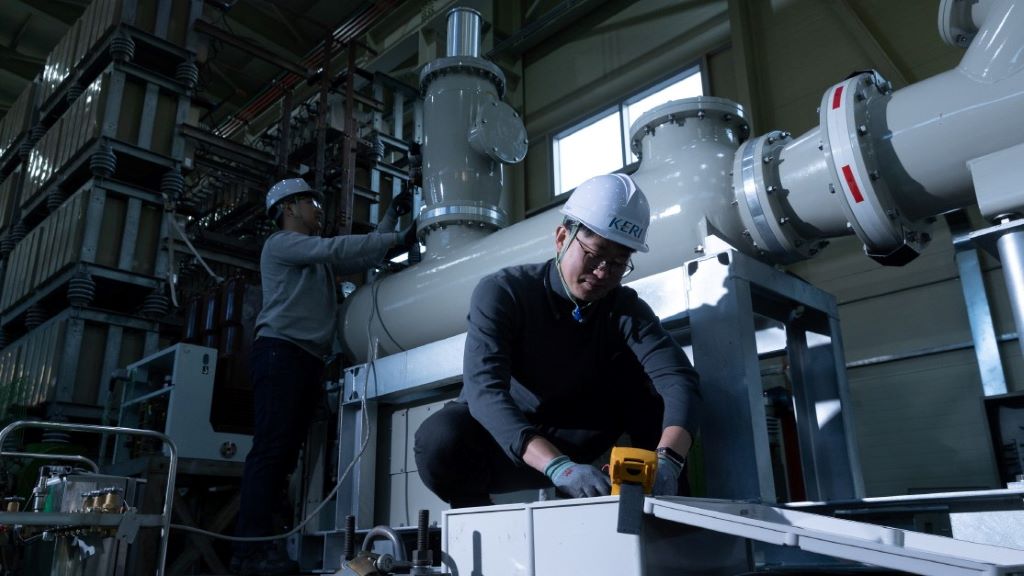한국전기연구원(KERI)이 온난화 지수가 높은 특수가스인 SF6(육불화황)을 대체할 수 있는 특수가스가 개발돼 향후 탄소저감에 크게 기여할 수 있을 것으로 기대가 모아진다.
 세계 최고 수준 개발·적용, 국제 규격 차단 성능 시험 통과
세계 최고 수준 개발·적용, 국제 규격 차단 성능 시험 통과
한국전기연구원(KERI)이 온난화 지수가 높은 특수가스인 SF6(육불화황)을 대체할 수 있는 특수가스가 개발돼 향후 탄소저감에 크게 기여할 수 있을 것으로 기대가 모아진다.
KERI는 전력기기 분야에서 지구온난화의 주범인 SF6(육불화황)를 대체하는 세계 최고 수준의 ‘친환경 절연가스’를 개발하고, 이를 초고압 송전급 차단기까지 적용할 수 있는 설계기술을 개발했다고 1일 밝혔다.
전력기기는 당연히 전기가 잘 통해야 하지만, 돌발사고 대비 및 안전상의 이유 등으로 전기를 차단하는 ‘절연(insulation)’ 기능도 반드시 필요하다.
SF6 가스는 절연 성능이 우수하고, 계통에 고장이 발생할 경우 고장전류를 차단하는 아크소호 성능이 다른 어떤 가스와 비교해도 월등하게 뛰어나 전력기기 분야에서 50년 넘게 사용되어 왔다.
반면에 SF6는 지구온난화에 영향을 미치는 지수(Global Warming Potential)가 이산화탄소의 2만3,500배에 이르며, 대기에 한 번 누출되면 무려 3,200년을 존재하면서 환경에 악영향을 미친다.
우리나라 역시 한국전력이 배출하는 온실가스 총배출량의 상당 부분을 SF6 가스가 차지하고 있어 기후위기 대응 및 탄소중립 실현을 위해 대체제 개발 연구가 시급하다.
이러한 SF6를 대체할 수 있는 친환경 가스 개발을 위해 전 세계적으로 많은 노력을 기울이고 있는 상황이지만, 신약 개발 이상의 난이도와 도전성이 요구되어 확실한 결과를 가져오지 못했다.
KERI는 이러한 높은 실패 가능성에도 불구하고, SF6 대체가스 개발 성공이 가져올 엄청난 기대효과와 글로벌 탄소 배출 규제에 대응해야 하는 국책 연구기관으로서의 사명감으로 관련 연구개발을 시작했다.
먼저 현재 산업군에서 사용하고 있는 가스 중 지구온난화 지수가 낮은 물질을 우선적으로 분류했고, 선별된 1차 후보군에 대한 전기적·화학적 특성을 정밀 분석하여 2차 후보군을 정했다. 이후 절연 및 폭발·발화 제어 성능시험 결과를 통해 최종 후보 물질들을 선정했고, 전력기기에 적용하기 위한 최적의 비율을 도출하여 친환경 절연가스를 개발할 수 있었다. KERI는 독자적으로 개발한 이 가스의 명칭을 ‘K6’로 정했다.
K6 가스는 지구온난화 지수가 1 미만으로 환경친화적이고, 심각한 독성 성분도 보유하고 있지 않다. 가스를 전력기기에 적용하기 위해 필수 조건인 ‘끓는점’도 낮아(-26℃) 대부분의 지역에서 안정적으로 기체의 특성을 갖는다.
KERI는 더 나아가 개발한 K6 가스를 초고압(145kW) 송전급 차단기에 적용하고, 국제전기기술위원회(IEC) 국제 규격에 따른 차단 성능 시험까지 통과했다.
특히 초고압 송전급 차단기는 절연가스 적용이 가장 어려운 분야로 손꼽힌다. KERI는 이번 시험 통과를 기반으로 배전에서 송전에 이르는 다양한 전력기기(차단기, 변압기, 개폐기 등)에 K6 가스를 적용한다는 계획이다.
KERI 오연호 친환경전력기기연구센터장은 “K6 가스는 그동안 해외 선진업체가 주도해 온 절연가스보다 더욱 성능이 뛰어나고 친환경적”이라며 “우리나라가 글로벌 전력기기 산업에서 수출 최상위권을 차지하는 만큼 K6 가스의 개발은 환경은 물론, 경제·산업적으로 파급력이 매우 클 것”이라고 전했다.
연구팀은 국내 전력기기 업체와의 기술이전을 통해 상용화를 준비한다는 계획이다. 또한, 산업 현장과의 꾸준한 소통을 통해 친환경 가스의 폭넓은 활용을 위한 명확한 설계기준을 확립하는 등 국내 전력기기 업계 경쟁력 강화에 기여한다는 목표다.
한편 KERI는 과학기술정보통신부 국가과학기술연구회 산하 정부출연연구기관이다. 이번 연구는 한국화학연구원, 한국표준과학연구원, 한국핵융합에너지연구원, 안전성평가연구소와 함께 진행됐다.
